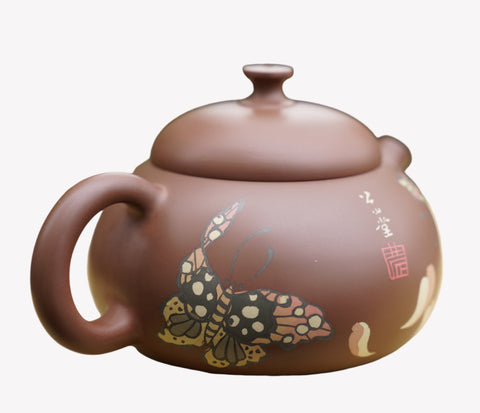Say Hello to Jian Shui Zi Tao Purple Clay Teapots!
Ever wonder what a Jian Shui Purple Clay teapot is? Ever wonder how Zi Tao pottery differs from Yixing? Do you know which is best for you?

If these or other questions have crossed your mind as you explore the world of fine and unique teawares, then this is the post for you. Like Yixing, Jian Shui pottery hails from Yunnan, and it too has a rich history that dates back hundreds of years. Sometimes known as “red jade,” the artisans who produce these wares devote countless hours to creating a single piece.
When using propane or kerosene in a kiln, approximately one out of five pieces will fail, and when a kiln is wood-fired, the failure rate can double or triple. Given the higher probability of losing a piece during wood-firing (as well as the longer firing times), these pieces are often sold on the market at double and triple the price. This is also why you will see different pricing tiers for Jian Shui teapots, as not all of them are wood-fired.
But another factor that influences price is the prestige of the artisan. Generally, younger artists who have not yet earned their renown will still create some outstanding teapots, but their relative anonymity entails that their pieces are not sold at the premium commanded by master artists, especially those recognized by national governing authority, such as Tian Jing.

Much of this comes down to simple supply and demand as well as the amount of labor required to produce a piece. In short, young artisans create many more teapots than master artists, who spend much of their time perfecting each and every single piece. Fewer teapots and more demand? You probably get the picture.
This helps explain the varying prices you can find in the market when perusing Jian Shui wares, but what, exactly, is a Jian Shui teapot, and how is it different from Yixing?
It is well-known that much of the clay around Yixing has been overused, and as a result, it has become increasingly difficult to produce an authentic, true origin Yixing teapot. This means, unfortunately, that many counterfeit pieces are created, traded, and sold—a risk especially for those new to these wares. To be sure, you can still find excellent, authentic Yixing wares. It’s just difficult and expensive.
This background is important because all of the problems that plague the Yixing market are mostly absent from the Jian Shui market. There’s still plenty of local clay available, and many artists use traditional methods and craft masterwork teapots consistent with those made during the Qing Dynasty.
What this means for the teaware collector is that, dollar-for-dollar, a Jian Shui teapot is often the better value.

Think of it as the difference between choosing an entry-level luxury car (Yixing) or the premium-level economy brand (Jian Shui). Obviously, the luxury car is really nice and has a wonderful reputation, but some of us might prefer to have all of the bells and whistles for the same price, even if it comes without the name recognition.
Like the luxury car, there are some important and distinct advantages to Yixing.
True Yixing teapots are made from very porous clay, and so these teapots can have thinner walls and more breathable, making them suitable for brewing all kinds of teas. The tradeoff in savings with a Jian Shui piece is a denser, heavier clay, a teapot best used with higher temperature teas such as dark oolongs, black teas, and pu-erh teas.
For many, this won’t make any difference in everyday use.
In short, both wares are excellent, offering similar advantages while differing in relatively minimal ways. If Jian Shui purple clay is the Toyota of teawares, then Yixing is its Lexus counterpart. You obviously cannot go wrong with either, and to a degree, it comes down to your personal preference and budget.
For these reasons, we’re pleased to offer both of these beautiful wares to you, and if you have any questions at all, do not hesitate to reach out to us!

Maria Mori on
Is the teapot glazed? Signed? Is there certificate of authenticity? How much of the body is hand made? How much is mold?